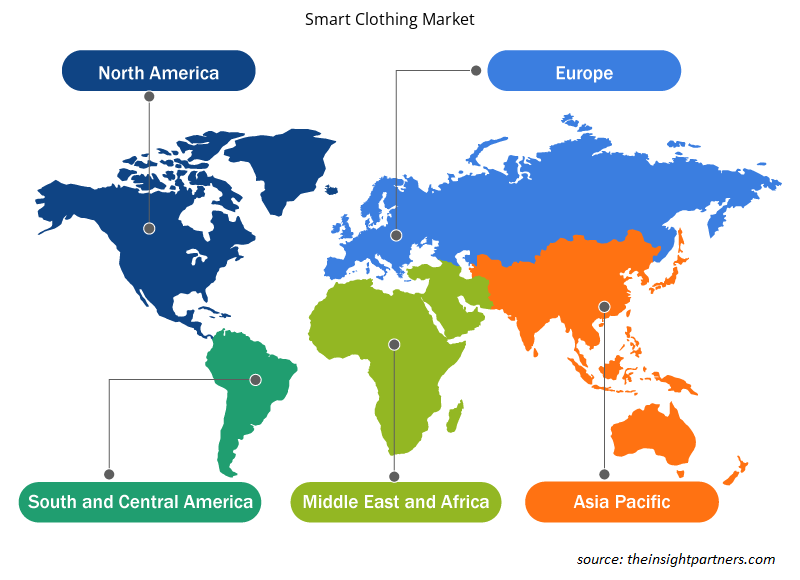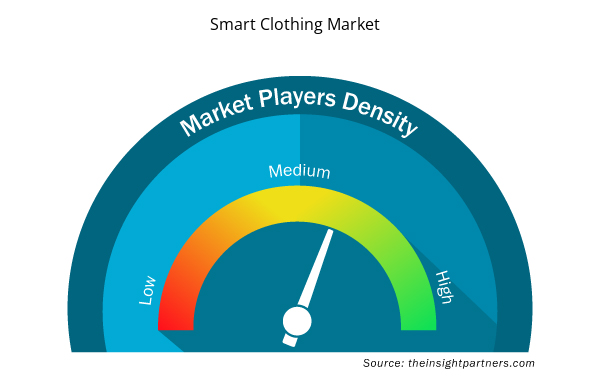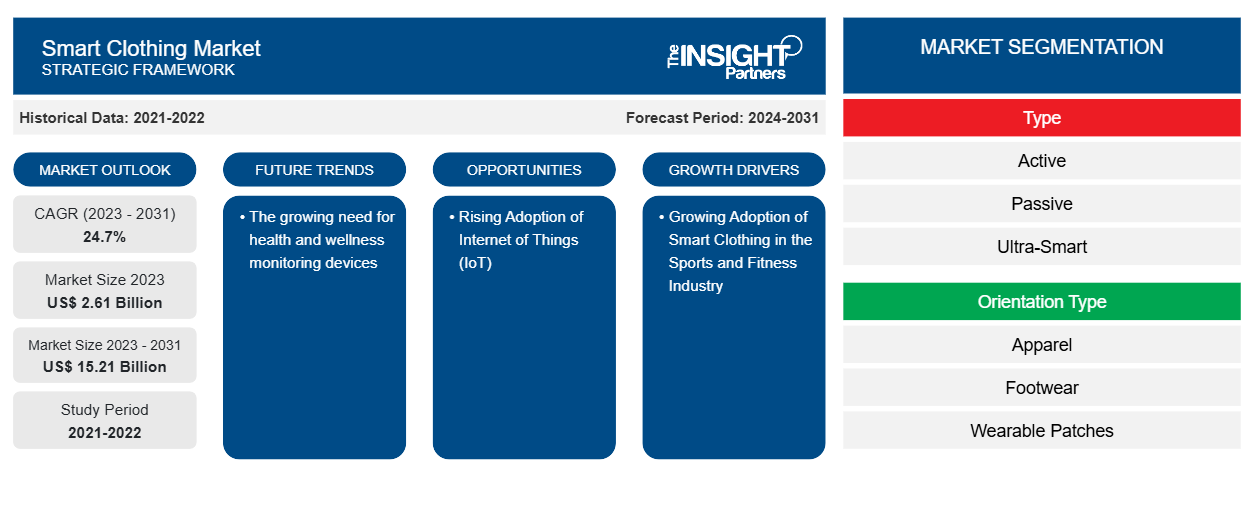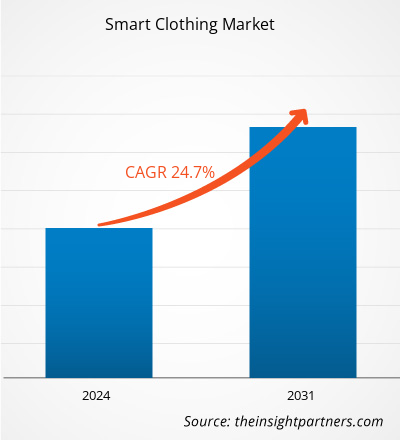Si prevede che la dimensione del mercato dell'abbigliamento intelligente raggiungerà i 15,21 miliardi di dollari entro il 2031, rispetto ai 2,61 miliardi di dollari del 2023. Si prevede che il mercato registrerà un CAGR del 24,7% nel 2023-2031. La crescente necessità di dispositivi di monitoraggio della salute e del benessere rimarrà probabilmente una tendenza chiave del mercato dell'abbigliamento intelligente.
Analisi del mercato dell'abbigliamento intelligente
Il mercato dell'abbigliamento intelligente sta crescendo a un ritmo rapido a causa della crescente adozione di abbigliamento intelligente nel settore dello sport e del fitness e della crescente adozione di sensori per il monitoraggio delle attività corporee. Il mercato si sta espandendo costantemente, guidato dalla crescente adozione di dispositivi indossabili. Inoltre, la crescente adozione dell'Internet of Things (IoT) sta offrendo opportunità redditizie per la crescita del mercato.IoT) is providing lucrative opportunities for market growth.
Panoramica del mercato dell'abbigliamento intelligente
L'abbigliamento intelligente incorpora l'elettronica negli indumenti per migliorare l'utilità e la connettività. Questi indumenti possono raccogliere dati biometrici , misurare i livelli di attività, regolare la temperatura e persino fornire un feedback tattile. Il mercato dell'abbigliamento intelligente fornisce indumenti rivoluzionari dotati di sensori e tecnologie che rivoluzionano l'uso quotidiano. Questi indumenti migliorano la gestione della salute e dello stile di vita, tra cui il monitoraggio del fitness e il monitoraggio biometrico . Forniscono dati in tempo reale, consentendo agli utenti di prendere decisioni informate sulla propria salute. L'uso di tessuti intelligenti in un modo non solo migliora la praticità, ma incoraggia anche un approccio proattivo alla salute, che aumenta la domanda tra i consumatori. Quindi, guidando il mercato.
Personalizza questo report in base alle tue esigenze
Riceverai la personalizzazione gratuita di qualsiasi report, comprese parti di questo report, o analisi a livello nazionale, pacchetto dati Excel, oltre a usufruire di grandi offerte e sconti per start-up e università
- Scopri le principali tendenze di mercato in questo rapporto.Questo campione GRATUITO includerà analisi di dati che spaziano dalle tendenze di mercato alle stime e alle previsioni.
Driver e opportunità del mercato dell'abbigliamento intelligente
La crescente adozione di abbigliamento intelligente nel settore dello sport e del fitness sta guidando il mercato
L'abbigliamento intelligente ha un potenziale enorme nel settore dello sport e del fitness. Atleti e appassionati di fitness stanno adottando ampiamente l'abbigliamento intelligente per i suoi vantaggi, come il monitoraggio in tempo reale di dati fisiologici come saturazione dell'ossigeno, attività muscolare, frequenza cardiaca e schemi di movimento. Questi dati sono utili per perfezionare i programmi di allenamento, ridurre i rischi di infortuni e migliorare le prestazioni complessive. Inoltre, l'attrezzatura intelligente fornisce feedback su postura, tecnica e forma, consentendo agli sportivi di apportare modifiche e migliorare le proprie routine di allenamento. L'integrazione di abbigliamento intelligente con dispositivi indossabili e app mobili aiuta gli utenti a creare un ecosistema di fitness olistico che fornisce informazioni e raccomandazioni personalizzate agli utenti che desiderano migliorare i propri obiettivi di salute.
Crescente adozione dell’Internet delle cose ( IoT ) – Un’opportunità nel mercato dell’abbigliamento intelligente
La crescita dell'IoT consente l'integrazione senza soluzione di continuità di indumenti intelligenti con smartphone e smartwatch. Questa connettività migliora le esperienze degli utenti e abilita nuove funzionalità, che dovrebbero creare opportunità sul mercato. La proliferazione dell'IoT rende l'abbigliamento intelligente una parte sempre più importante dell'ecosistema interconnesso, offrendo agli utenti una praticità e una varietà senza pari nella loro vita quotidiana. Inoltre, la crescente domanda di abbigliamento intelligente incoraggia i produttori a sviluppare soluzioni tecnologicamente avanzate per soddisfare le richieste dei consumatori. Ad esempio, nell'aprile 2023, i ricercatori dell'Università di Waterloo hanno creato un rivoluzionario "tessuto intelligente" fatto di fibre nanocomposite polimeriche integrate con fili di acciaio inossidabile. Questo tessuto ha una particolare risposta al calore e all'elettricità, con fili incorporati che si contraggono e cambiano forma quando vengono riscaldati.
Analisi della segmentazione del rapporto di mercato dell'abbigliamento intelligente
I segmenti chiave che hanno contribuito alla derivazione dell'analisi di mercato dell'abbigliamento intelligente sono tipologia, tipo di orientamento, connettività e utente finale.
- In base al tipo, il mercato dell'abbigliamento intelligente è diviso in attivo, passivo e ultra-intelligente. Il segmento attivo ha detenuto una quota di mercato maggiore nel 2023.
- In termini di tipo di orientamento, il mercato è segmentato in abbigliamento, calzature, toppe indossabili e altri. Il segmento dell'abbigliamento ha detenuto una quota di mercato maggiore nel 2023.
- Sulla base della connettività, il mercato dell'abbigliamento intelligente è suddiviso in Wi-Fi, Bluetooth, GPS e RFID. Il segmento GPS ha detenuto una quota di mercato maggiore nel 2023.
- In termini di utente finale, il mercato è categorizzato come sanità, moda e stile di vita, sport e fitness, militare e altri. Il segmento sport e fitness ha detenuto una quota di mercato maggiore nel 2023.
Analisi della quota di mercato dell'abbigliamento intelligente per area geografica
L'ambito geografico del rapporto sul mercato dell'abbigliamento intelligente è suddiviso principalmente in cinque regioni: Nord America, Asia Pacifico, Europa, Medio Oriente e Africa e Sud America/Sud e Centro America.
In termini di fatturato, il Nord America ha rappresentato la quota di mercato più grande per l'abbigliamento intelligente, grazie all'iniziativa favorevole del governo per promuovere la tecnologia dell'abbigliamento intelligente. Ad esempio, a settembre 2023, il governo degli Stati Uniti ha investito 22 milioni di dollari per promuovere l'iniziativa smart e-pants per far progredire la tecnologia dell'abbigliamento di sorveglianza intelligente. Il governo sta pianificando di creare indumenti indossabili che tracciano la geolocalizzazione, registrano audio/video e monitorano i dati fisiologici per il personale militare e le agenzie di intelligence. Ciò aumenta la consapevolezza della situazione e la raccolta di dati in ambienti pericolosi.
Approfondimenti regionali sul mercato dell'abbigliamento intelligente
Le tendenze regionali e i fattori che influenzano il mercato dell'abbigliamento intelligente durante il periodo di previsione sono stati ampiamente spiegati dagli analisti di Insight Partners. Questa sezione discute anche i segmenti e la geografia del mercato dell'abbigliamento intelligente in Nord America, Europa, Asia Pacifico, Medio Oriente e Africa e Sud e Centro America.

- Ottieni i dati specifici regionali per il mercato dell'abbigliamento intelligente
Ambito del rapporto sul mercato dell'abbigliamento intelligente
| Attributo del report | Dettagli |
|---|---|
| Dimensioni del mercato nel 2023 | 2,61 miliardi di dollari USA |
| Dimensioni del mercato entro il 2031 | 15,21 miliardi di dollari USA |
| CAGR globale (2023-2031) | 24,7% |
| Dati storici | 2021-2022 |
| Periodo di previsione | 2024-2031 |
| Segmenti coperti | Per tipo
|
| Regioni e Paesi coperti | America del Nord
|
| Leader di mercato e profili aziendali chiave |
|
Densità degli attori del mercato dell'abbigliamento intelligente: comprendere il suo impatto sulle dinamiche aziendali
Il mercato Smart Clothing Market sta crescendo rapidamente, spinto dalla crescente domanda degli utenti finali dovuta a fattori quali l'evoluzione delle preferenze dei consumatori, i progressi tecnologici e una maggiore consapevolezza dei vantaggi del prodotto. Con l'aumento della domanda, le aziende stanno ampliando le loro offerte, innovando per soddisfare le esigenze dei consumatori e capitalizzando sulle tendenze emergenti, il che alimenta ulteriormente la crescita del mercato.
La densità degli operatori di mercato si riferisce alla distribuzione di aziende o società che operano in un particolare mercato o settore. Indica quanti concorrenti (operatori di mercato) sono presenti in un dato spazio di mercato in relazione alle sue dimensioni o al valore di mercato totale.
Le principali aziende che operano nel mercato dell'abbigliamento intelligente sono:
- Abbigliamento intelligente AiQ Inc.
- Carve Technologies Inc. (Skin per la pelle)
- CARINOCIRCUITO
- Applico, sro
- Italiano:
- Myontec Italia
Disclaimer : le aziende elencate sopra non sono classificate secondo un ordine particolare.

- Ottieni una panoramica dei principali attori del mercato dell'abbigliamento intelligente
Notizie e sviluppi recenti sul mercato dell'abbigliamento intelligente
Il mercato dell'abbigliamento intelligente viene valutato raccogliendo dati qualitativi e quantitativi dopo la ricerca primaria e secondaria, che include importanti pubblicazioni aziendali, dati associativi e database. Di seguito è riportato un elenco degli sviluppi nel mercato dell'abbigliamento intelligente e delle strategie:
- Ad aprile 2023, H & M Hennes & Mauritz GBC AB ha collaborato con LanzaTech per offrire ai propri clienti una capsule collection realizzata in poliestere CarbonSmart, un materiale rivoluzionario che utilizza emissioni di carbonio riutilizzate. Questa partnership consente a H&M Move di esplorare materiali innovativi e di fare la propria parte per contribuire a creare abbigliamento sportivo intelligente e più sostenibile in futuro. (Fonte: H & M Hennes & Mauritz GBC AB, comunicato stampa, 2023)
Copertura e risultati del rapporto sul mercato dell'abbigliamento intelligente
Il rapporto "Dimensioni e previsioni del mercato dell'abbigliamento intelligente (2021-2031)" fornisce un'analisi dettagliata del mercato che copre le seguenti aree:
- Dimensioni e previsioni del mercato a livello globale, regionale e nazionale per tutti i segmenti di mercato chiave coperti dall'ambito
- Dinamiche di mercato come fattori trainanti, vincoli e opportunità chiave
- Principali tendenze future
- Analisi dettagliata delle cinque forze PEST/Porter e SWOT
- Analisi di mercato globale e regionale che copre le principali tendenze di mercato, i principali attori, le normative e gli sviluppi recenti del mercato
- Analisi del panorama industriale e della concorrenza che copre la concentrazione del mercato, l'analisi della mappa di calore, i principali attori e gli sviluppi recenti
- Profili aziendali dettagliati
- Analisi storica (2 anni), anno base, previsione (7 anni) con CAGR
- Analisi PEST e SWOT
- Valore/volume delle dimensioni del mercato - Globale, regionale, nazionale
- Industria e panorama competitivo
- Set di dati Excel



Report Coverage
Revenue forecast, Company Analysis, Industry landscape, Growth factors, and Trends

Segment Covered
This text is related
to segments covered.

Regional Scope
North America, Europe, Asia Pacific, Middle East & Africa, South & Central America

Country Scope
This text is related
to country scope.
Domande frequenti
The incremental growth expected to be recorded for the global smart clothing market during the forecast period is US$ 12.60 billion.
The global smart clothing market is expected to reach US$ 15.21 billion by 2031.
The key players holding majority shares in the global smart clothing market are AiQ Smart Clothing Inc., Carve Technologies Inc. (Hexoskin), CUTECIRCUIT, Applycon, s. r. o., and Jabil Inc.
The growing need for health and wellness monitoring devices to play a significant role in the global smart clothing market in the coming years.
The growing adoption of smart clothing in the sports and fitness industry and the increasing adoption of sensors for monitoring bodily activities are the major factors that propel the global smart clothing market.
The global smart clothing market was estimated to be US$ 2.61 billion in 2023 and is expected to grow at a CAGR of 24.7% during the forecast period 2023 - 2031.
Trends and growth analysis reports related to Electronics and Semiconductor : READ MORE..
The Insight Partners performs research in 4 major stages: Data Collection & Secondary Research, Primary Research, Data Analysis and Data Triangulation & Final Review.
- Data Collection and Secondary Research:
As a market research and consulting firm operating from a decade, we have published and advised several client across the globe. First step for any study will start with an assessment of currently available data and insights from existing reports. Further, historical and current market information is collected from Investor Presentations, Annual Reports, SEC Filings, etc., and other information related to company’s performance and market positioning are gathered from Paid Databases (Factiva, Hoovers, and Reuters) and various other publications available in public domain.
Several associations trade associates, technical forums, institutes, societies and organization are accessed to gain technical as well as market related insights through their publications such as research papers, blogs and press releases related to the studies are referred to get cues about the market. Further, white papers, journals, magazines, and other news articles published in last 3 years are scrutinized and analyzed to understand the current market trends.
- Primary Research:
The primarily interview analysis comprise of data obtained from industry participants interview and answers to survey questions gathered by in-house primary team.
For primary research, interviews are conducted with industry experts/CEOs/Marketing Managers/VPs/Subject Matter Experts from both demand and supply side to get a 360-degree view of the market. The primary team conducts several interviews based on the complexity of the markets to understand the various market trends and dynamics which makes research more credible and precise.
A typical research interview fulfils the following functions:
- Provides first-hand information on the market size, market trends, growth trends, competitive landscape, and outlook
- Validates and strengthens in-house secondary research findings
- Develops the analysis team’s expertise and market understanding
Primary research involves email interactions and telephone interviews for each market, category, segment, and sub-segment across geographies. The participants who typically take part in such a process include, but are not limited to:
- Industry participants: VPs, business development managers, market intelligence managers and national sales managers
- Outside experts: Valuation experts, research analysts and key opinion leaders specializing in the electronics and semiconductor industry.
Below is the breakup of our primary respondents by company, designation, and region:

Once we receive the confirmation from primary research sources or primary respondents, we finalize the base year market estimation and forecast the data as per the macroeconomic and microeconomic factors assessed during data collection.
- Data Analysis:
Once data is validated through both secondary as well as primary respondents, we finalize the market estimations by hypothesis formulation and factor analysis at regional and country level.
- Macro-Economic Factor Analysis:
We analyse macroeconomic indicators such the gross domestic product (GDP), increase in the demand for goods and services across industries, technological advancement, regional economic growth, governmental policies, the influence of COVID-19, PEST analysis, and other aspects. This analysis aids in setting benchmarks for various nations/regions and approximating market splits. Additionally, the general trend of the aforementioned components aid in determining the market's development possibilities.
- Country Level Data:
Various factors that are especially aligned to the country are taken into account to determine the market size for a certain area and country, including the presence of vendors, such as headquarters and offices, the country's GDP, demand patterns, and industry growth. To comprehend the market dynamics for the nation, a number of growth variables, inhibitors, application areas, and current market trends are researched. The aforementioned elements aid in determining the country's overall market's growth potential.
- Company Profile:
The “Table of Contents” is formulated by listing and analyzing more than 25 - 30 companies operating in the market ecosystem across geographies. However, we profile only 10 companies as a standard practice in our syndicate reports. These 10 companies comprise leading, emerging, and regional players. Nonetheless, our analysis is not restricted to the 10 listed companies, we also analyze other companies present in the market to develop a holistic view and understand the prevailing trends. The “Company Profiles” section in the report covers key facts, business description, products & services, financial information, SWOT analysis, and key developments. The financial information presented is extracted from the annual reports and official documents of the publicly listed companies. Upon collecting the information for the sections of respective companies, we verify them via various primary sources and then compile the data in respective company profiles. The company level information helps us in deriving the base number as well as in forecasting the market size.
- Developing Base Number:
Aggregation of sales statistics (2020-2022) and macro-economic factor, and other secondary and primary research insights are utilized to arrive at base number and related market shares for 2022. The data gaps are identified in this step and relevant market data is analyzed, collected from paid primary interviews or databases. On finalizing the base year market size, forecasts are developed on the basis of macro-economic, industry and market growth factors and company level analysis.
- Data Triangulation and Final Review:
The market findings and base year market size calculations are validated from supply as well as demand side. Demand side validations are based on macro-economic factor analysis and benchmarks for respective regions and countries. In case of supply side validations, revenues of major companies are estimated (in case not available) based on industry benchmark, approximate number of employees, product portfolio, and primary interviews revenues are gathered. Further revenue from target product/service segment is assessed to avoid overshooting of market statistics. In case of heavy deviations between supply and demand side values, all thes steps are repeated to achieve synchronization.
We follow an iterative model, wherein we share our research findings with Subject Matter Experts (SME’s) and Key Opinion Leaders (KOLs) until consensus view of the market is not formulated – this model negates any drastic deviation in the opinions of experts. Only validated and universally acceptable research findings are quoted in our reports.
We have important check points that we use to validate our research findings – which we call – data triangulation, where we validate the information, we generate from secondary sources with primary interviews and then we re-validate with our internal data bases and Subject matter experts. This comprehensive model enables us to deliver high quality, reliable data in shortest possible time.


 Ottieni un campione gratuito per questo repot
Ottieni un campione gratuito per questo repot